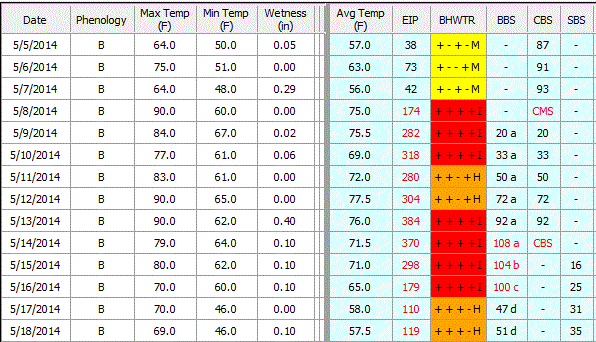FIRE BLIGHT ALERT: The risk column of Maryblyt 7 graphic below, based on predicted temperatures and wetting for May 14-18, shows that fire blight risk will remain extremely high through Friday, May 16 wherever bloom is present. In high-risk situations, a protective streptomycin application is recommended ahead of predicted infection conditions. In the event of hail injury or other trauma blight situation, apply streptomycin as soon as possible after the event. Routine spray applications can provide enough wetting to meet the wetting requirement for infection if all other infection conditions have been met and this would have been true for May 11-12. Under the warm temperature conditions shown for the this week, streptomycin remains residually effective for only about 3 days.
With this fire blight pressure, you still might want to consider applying the plant growth regulator, Apogee to suppress shoot blight if hail or another trauma blight event were to occur. Optimum timing of the first Apogee application for this purpose is at petal fall on king bloom, and a suppressive effect should not be expected until 7-10 after Apogee application.
The temperature and rainfall data are current through Wednesday morning, May 14, for the graphic above from the Maryblyt 7 program. Predicted weather conditions are shown for May 12-16. The components of fire blight risk are indicated in the columns labeled B (blossoms open), H (degree hours for epiphytic bacterial population buildup, EIP >100), W (wetting by rain or dew), and T (average daily temperature 60 F or above).
The BBS column is tracking predicted appearance of blossom blight symptoms from infection May 8 to predicted symptom appearance (108a) May 14. The CBS column at the right in the graphic indicates progression toward the appearance of canker blight symptoms on new growth, due to extension of overwintering cankers from last year, with canker margin symptoms (CMS) by May 8 and canker blight symptoms May 14. Canker advancement cannot be prevented by a chemical treatment, and the presence of symptoms will indicate a build-up of inoculum which could become a factor in the event of a trauma blight situation due to hail injury, etc. The weather conditions used in the predictive part of this graphic come from the Weather Channel for Winchester, supplemented by site-specific data from SkyBit Inc.
SCAB and RUSTS: An apple scab and rust infection period is in progress, with more than 14 hr of wetting and temperatures in the mid-60s. Much cedar-apple and quince rust inoculum is still available and many small unprotected fruits are still susceptible. We are now into a heavy secondary scab situation where scab was not adequately controlled on Apr 11-12, Apr 14-15, or Apr 28-May 1. This wetting period also favors infection by peach scab.

